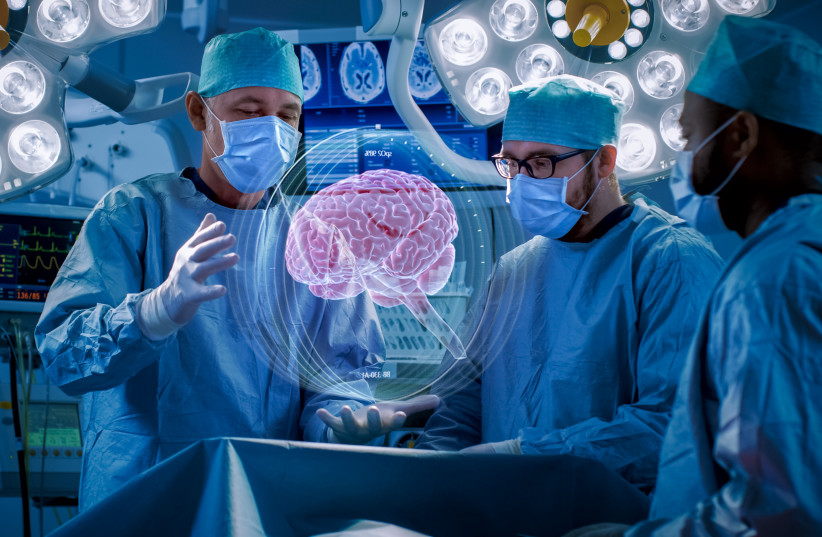The Jerusalem Post has partnered with ExitValley, a digital platform that enables anyone to invest in Israel's startup ecosystem and share in its success. In this article, we are pleased to introduce SynCath Neuroscience, an Israeli company that helps prevent severe brain damage and unnecessary brain surgery in patients suffering from traumatic head injuries.
SynCath's innovative solution utilizes an advanced cardiac-synchronized balloon - catheter, providing neurosurgeons with long-awaited & mission-critical, real-time data regarding patients’ evolving brain pressure crisis in cases of severe head injury or cerebral hemorrhage, and allowing them a novel, highly effective physiology-based, minimally invasive therapy that augments critically severed oxygen supply to brain cells..
The system's efficacy and safety have been proven in extensive preclinical trials, and it is meant for use as a tool to increase blood flow and oxygen supply to the brain. Furthermore, by predicting an intracranial-pressure crisis, it is designed to avoid complex and dangerous surgeries, when unnecessary and alert their necessity in the few unavoidable cases.


The tech was developed by Prof. Ofer Barnea and Dr. Omer Doron, in collaboration with Prof. Guy Rosenthal, Director of Neurosurgical Intensive Care at Hadassah Medical Center, by combining elements of personalized medicine, machine learning, interventional neurology and advanced mathematical modeling. These experts have succeeded in creating groundbreaking technology for neurocritical treatment, for which SynCath holds the exclusive worldwide license. The patents used for the technology are in advanced registration stages around the world, and have already been granted in China.
“Neurosurgical injuries in general, and traumatic head injuries particularly, usually happen surprisingly, at almost any age, as a result of a variety of events: from sports injuries, car or bicycle accidents, to stroke or violent events,” says Prof. Barnea, “all of which require urgent and effective medical care to lessen the possibility of irreversible damage to the brain and prevent loss of life. The brain damage caused by traumatic brain injury is irreversible and may damage the quality of life, creating a dependence on caregivers, at a high financial cost. Receiving the proper treatment at the right moment is critical to preventing the loss of additional brain cells.
“In traumatic head injury (TBI), subarachnoid hemorrhage (SAH) and bleeding due to hemorrhagic stroke and aneurysm (ICH), the result is a significant increase in intracranial pressure, as a result of edema in brain tissue, he adds. “The increase in pressure causes blood vessels to partially collapse, leading to a significant decrease in blood flow to the brain, and the supply of oxygen to the brain tissue, accordingly.”
The immediate form of treatment available today is limited in terms of how much and for how long it can actually help these patients. Current treatment includes a Mannitol solution (polysaccharide) to extract fluids from the brain cells and relieve some of the intracranial pressure, inserting intracerebral drainage into the brain for expelling fluids, and finally, the removal of a large portion of the skull to allow brain tissue to expand and lower this pressure.
These treatments – the use of a catheter and the partial removal of the skull – , are medical procedures that were invented more than a hundred years ago. The treatment methods are still currently limited, and there is great importance and a significant need to develop new tools for treatment in cases where significant impairment of brain functions or even death may occur.
“Monitoring intracranial pressure is a critical procedure in treating brain injuries, but the existing process does not allow the neurosurgeon to understand what is really going on inside the skull of the patient, as it's based only on general statistical data rather than on the individual patient”, says Prof. Barnea. “The problem is that for each patient, the level of critical pressure at which dramatic intervention is needed is different. This is where SynCath's innovative system comes into play, providing neurosurgeons with an effective tool for continuously assessing the exact condition of each and every patient”.
The critical parameter that the device measures, which is not yet available to neurosurgeons, is intracranial elasticity, and it estimates the amount of fluid that can still accumulate in the brain before high pressure breaks the brain tissue (herniation) and causes severe damage. Another result of the intracranial pressure is also a partial collapse of blood vessels. SynCath's technology also addresses this issue, as it includes the ability to assess the blood flow in the brain.
The same system, when operated in a different mode, acts as an ingenious pressure modulator, acting as a pump to augment blood flow in the brain and increase oxygen supply to brain cells, thereby reducing the death of brain cells.
“A catheter with a balloon at its tip, integrated with the commonly used drain, is inserted into a brain cavity in the exact same manner as drains are inserted today”, Prof. Barnea explained. “The balloon at the tip of the catheter is momentarily inflated by about 1 ml at a specific time in the cardiac cycle. For the monitoring application, this perturbation is performed once every ten minutes. When operated as a pressure modulator, it is inflated momentarily at each cardiac cycle.
“The two monitored parameters are estimated based on active monitoring, as opposed to conventional passive monitoring using a sensor, such as a manometer. In active monitoring, on the other hand, a deliberate and specific perturbation is caused, and the patient's response to it is measured, which allows for the intracranial elasticity and blood flow to the brain parameters to be calculated.”
The company intends to expand this technology through further development to allow the use of a balloon to modulate the intracranial pressure, in a way that will increase the outflow of fluid through the draining catheter.
The revolutionary solution offered by SynCath, will include the current treatment option, in the form of an intracranial catheter, with the critical addition of the pressure measurement sensor, providing doctors with a full toolset to finally allow access to all currently available monitoring and treatment capabilities, topped off with SynCath's innovative monitoring and treatment capabilities.
Following discussions and consultations the company has held with well-known opinion leaders in the neurosurgical field, experts worldwide have stated their interest in using the company's technology in treating their patients.
The company's technology is designed for the use of the neurosurgical intensive care market, as well as the fast-growing trauma and stroke treatment markets, with hundreds of thousands of cases in the US, and over a million cases in Europe each year, requiring the kind of treatment for which SynCath's development is intended. The company expects that its technology could be used immediately to treat over 1.5 million patients every year, with a relevant primary market potential of billions of dollars.
For more information visit: www.exitvalley.com


